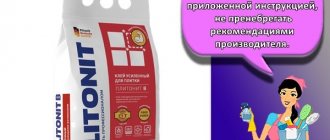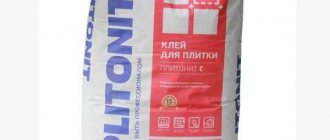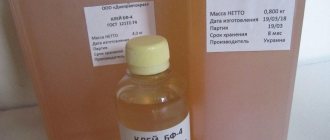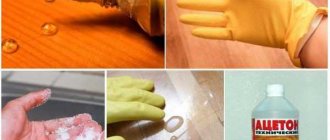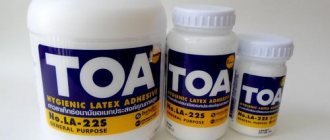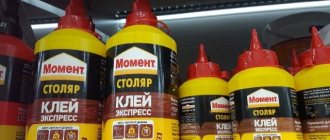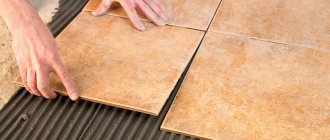Category: Recipes
NATURAL RUBBER GLUE
Application area. Rubber glue made from natural rubber according to recipe a (Table 5.4) is used: for bending, assembling workpieces made of natural leather (gluing interlining, leather lining, sidewalls, etc.), lining soles, gluing insoles; according to recipe b - for duplicating the interlining, for gluing the pieces when making a welt; according to recipe B - used for gluing leather and textile layers of welted insoles; according to recipe d with vulcanizing agents - for preliminary gluing of a rubber heel to a leather heel, for inserting soft and hard layers of the back, gluing the front with the sub-heel along the upper edge.
Compound. The recipe for natural rubber adhesives is given in Table 5.4.
| Table 5.4 | |||||
| Component | NTD | Mast recipe h. | |||
| A | b | V | G | ||
| Natural rubber | import | 6-10 | 15 | 9-14 | 8-14 |
| Nefras S2-80/120 and SZ-80/120 | GOST 443-76 | 94-90 | 85 | 88-76 | 92-86 |
| Pine rosin | GOST 19113-73 | — | — | 3-10 | — |
| Sulfur | GOST 127-76 | — | — | — | 0,24-0,42 |
| Zinc oxide | GOST 202-76 | — | — | — | 0,24-0,42 |
| Ethanol | GOST 18300-72 | 0-1 | 0-1 | 0-1 | 0-1 |
| Antistatic additive ASP-1 or sagbol | TU 38-101538-75 | 0-0,001 | 0-0,001 | 0-0,001 | 0-0,002 |
Cooking method. Bales of natural rubber are kept at a temperature of 50÷60 °C for 24 hours and cut into pieces to sizes suitable for plasticization on rollers. The rubber is plasticized on rollers for 3–5 minutes until a skin 3–5 mm thick is formed. Then the skin is cut into pieces, loaded into a glue mixer, poured with half the amount of nefras specified in the recipe, and mixed until a homogeneous mass is formed.
Simultaneously with loading the rubber, in order to reduce the static electricity that accumulates in the glue mixer during the glue production process, a 50% solution of the antistatic additive ASP-1 in nefras is poured. To accelerate the dissolution of rubber, the glue mixer is heated through a water jacket at a temperature of 30÷35 °C.
As the rubber dissolves, the remaining amount of nefras is added. When loading unplasticized rubber into the glue mixer, its dissolution time increases. A decrease in the viscosity of the glue is ensured by adding ethyl alcohol or AKR solvent to the solution in an amount of 1÷2% by weight of the glue.
Vulcanization ingredients (sulfur and zinc oxide - recipe d) are introduced into the rubber during the plasticization process on rollers.
Method of application. After applying natural rubber glue to the surfaces to be glued, the adhesive film is dried at ambient temperature for 15-45 minutes.
General characteristics of rubber adhesive
Essentially, rubber glue is a natural rubber that dissolves in special substances. After complete drying, the glue has a rubber-like structure.
As a rule, this adhesive contains polymer resins, special vulcanizing and cross-linking components.
Rubber glue is used both in repair work and in home use, most often for:
- Repairing a bicycle tube or rubber boat;
- Shoe and clothing repair;
- Floor covering fastenings;
- In the manufacture of vacuum products;
- Manufacturing and repair of furniture.
Some disadvantages of rubber glue are noted:
- It forms a not very beautiful glue seam.
- Due to the fact that there are quite a lot of solvents in the composition, it has an unpleasant aroma.
- It's quite difficult to apply.
- If handled incorrectly or carelessly, it can burn your skin.
If you smear any part of a product or material with it, it is almost impossible to wash it off.
Types of rubber glue
Based on the composition of rubber, all rubber adhesives are divided into 5 types:
- Glue made on natural rubber is of natural origin, so it does not tolerate high temperatures. As a rule, this type of glue is used when working with paper or cardboard objects, as well as for gluing leather and fabrics. In some cases it can be used when working with carpet.
- Chloroprene rubber adhesive has divalent metal oxides, due to which it has high strength, reliability, and excellent resistance to high temperatures. This type of glue is great for working with metal, glass, wood and plastic.
- Rubber adhesive made from nitrile butadiene rubber is highly water resistant and is used in various works.
- Organosilicon type rubber adhesive is characterized by very high heat resistance, but does not harden at all. This type of glue is good to use only for working with homogeneous rubber.
- Rubber butadiene-styrene adhesive has low bonding ability, so it is used for making adhesive tape or for artistic work.
Depending on the purpose for which the rubber glue is intended, it can be of the home or industrial type. For home use, it is packaged in a tube or bottle, and for industrial use - in a bucket, jar, barrel, and you need to use special tools to apply it.
Depending on the form in which the rubber adhesive is presented, it is divided into standard, thick adhesive paste (mastic), and adhesive sealant.
Peculiarities
Most often, rubber adhesive is used to join elastic parts. The fact is that after hardening, the structure is really similar to rubber. However, when purchasing such glue, you need to try to ensure that its composition is similar to the parts being joined.
The composition of rubber glue can include not only natural rubber, but also synthetic rubber. Ethyl acetate, chlorine-containing or organic compounds can be used as a solvent. The recipes of all manufacturers are different, so the properties of glue from different brands may differ.
The main feature of rubber-based glue is that it can be used with paper, textile, glass, wood, metal and other materials. It is widely used in the footwear, furniture and automobile industries. However, this glue can also be purchased for household purposes.
How to apply rubber cement
There are 2 types of gluing that are used when working with rubber glue: cold and hot method.
The cold gluing method is almost the same as when using simple glue. Work must be carried out at room temperature. To begin with, you should apply a thin layer of glue to the material, wait about 20 minutes, and then apply another layer and fasten the gluing elements.
Allow the product to dry thoroughly for 24-72 hours.
In order to perform hot gluing with rubber glue, it is necessary to heat the surface with glue to 80-170 degrees Celsius and connect the elements. If the glue does not have a quick-drying effect, then you should let the product dry for 3 hours.
Tips for using rubber cement.
- When working, the room temperature is not allowed to be less than +5 degrees Celsius, as the rate of hardening of the glue will greatly decrease.
- The thickness of the adhesive layer should not be thicker than 2 mm.
- For more reliable fixation, it is best to place the glued part under a press for a couple of hours.
- This glue is flammable, so do not use it near open fire.
- When gluing hot, it is best to use a hair dryer.
- When hot gluing is carried out, the glue releases many toxic substances, so this should be done in a well-ventilated area and in a respirator.
What can you glue rubber with?
Rubber can be bonded to various materials. To obtain a high-strength connection, it is worth choosing the right adhesive composition.
Metal
Sometimes you need to glue materials that are difficult to fix. These include metal and rubber. Typically, the adhesive does not harden on smooth metal, but rolls off. To bond such materials, substances TRS 4004, 103 88-NT, Leukonat, BF-2 are used.
To achieve reliable fixation of fragments, it is necessary to properly prepare the surfaces. First of all, it is recommended to clean the metal from rust or oils. After which it should be degreased. It is recommended to create a rough coating on the rubber and clean it with a degreasing compound.
The surfaces should dry, after which they should be covered with adhesive and wait a quarter of an hour. Then apply the glue again and wait for the film to appear - this will take 10 minutes.
Finally, you should fasten the fragments and press them firmly. If possible, it is recommended to heat the glued fragments and leave them to dry. The duration of this process depends on the composition.
To fix rubber with PVC, you should use glue 4508. This composition is characterized by high stickiness and resistance to moisture. It helps form an elastic seam and is often used for boat repairs.
Recommendations for choosing rubber adhesive
Experienced experts give several important tips that you should take note of when choosing rubber adhesive:
- It will be determined exactly how the gluing will be done, since each glue has its own temperature resistance standards.
- What types of material will rubber adhesive be used for?
- For thinner seams, it is recommended to use liquid glue, and for thick ones, thick rubber glue.
If the glued object will come into contact with food, then you should choose glue brands without toxic components.
The best rubber adhesives
Below is a list of brands and manufacturers of rubber glue that have proven themselves to be the best:
- Glue 88 N is a rubber glue from a Russian manufacturer, it has good strength and is excellent at gluing rubber to metal and other materials.
- Glue 88 CA is one of the most popular rubber adhesives, which consist of rubber without various impurities. Able to fix rubber well with concrete, wood, glass, as well as for working with leather and fabric.
- Radical is a rubber adhesive that is highly water resistant and not afraid of high temperatures. Great for repairing kayaks, rubber boats.
- Loctite 406 is a rubber adhesive that has a low viscosity but works quickly. This glue is recommended for gluing to plastic.
- Gummi rubber adhesive is made from natural rubber. This glue is quite waterproof and is recommended for gluing rubber and various inflatable objects.
- Moment-1 is one of the most popular rubber adhesives, but it is very toxic and flammable; you should work with it following all safety rules. This glue is considered universal, as it glues surfaces of various types.
Properties of a high-quality and reliable composition
A high-quality mixture will firmly connect the surfaces, fill voids, holes and seams, making the product airtight. Using a good product, you can repair tires, boats, rubber shoes, balls, tents, inflatable or water mattresses, and wetsuits.
Glue 4NB-UV
Characteristics of a good product:
- Resistance to moisture and high temperatures (from –40 to +100° C).
- Strength.
- Resistance to aggressive chemical compounds.
- Excellent filling capacity and flexibility.
- No unpleasant, pungent odor.
- Transparency.
